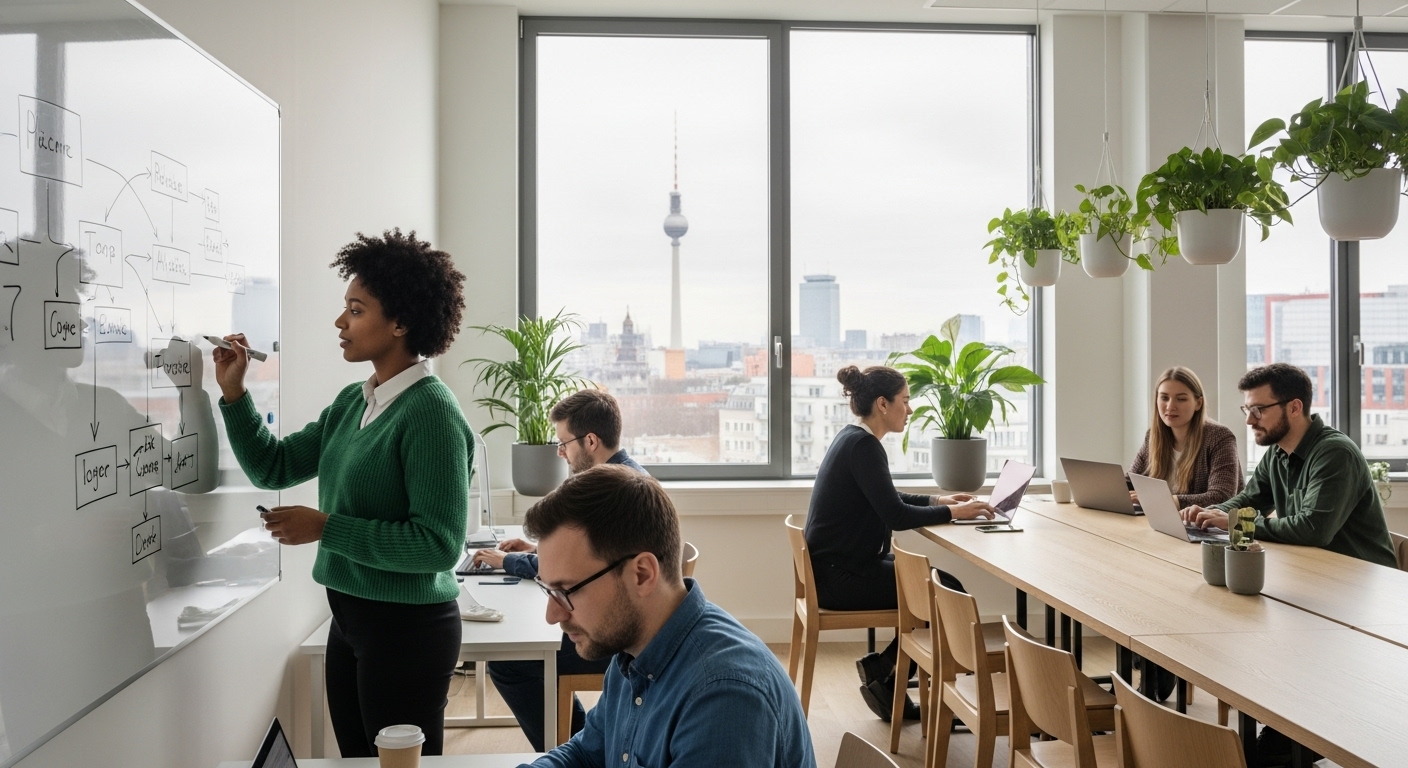In the vibrant, fast-paced world of Germany’s tech capital, the term ‘productivity’ takes on a new meaning. It’s no longer just about the classic German efficiency of ticking off tasks; it’s about channeling creative chaos into sustainable innovation and tangible results. For leaders in this dynamic ecosystem, the core challenge is building a team culture that not only embraces this energy but also provides the structure needed for deep, meaningful work. Generic, one-size-fits-all productivity hacks often fall flat here, failing to account for the city’s unique blend of artistic freedom and entrepreneurial drive. This guide is different. It’s a blueprint specifically designed for the Berlin context, offering actionable strategies to engineer a culture of focus and flow. We will explore how to establish psychological safety as a performance driver, design workflows that protect deep work, strategically deploy technology, and measure what truly matters: impact. By moving beyond activity metrics and towards a more holistic understanding of output, you can unlock your team’s full potential.
Defining productivity in the Berlin context
The traditional model of productivity, often measured in hours logged or tasks completed, feels increasingly outdated in Berlin’s forward-thinking business landscape. Here, a city teeming with international talent, startups, and creative agencies, productivity is more qualitative. It’s about the speed of innovation, the quality of creative problem-solving, and the agility to pivot in a constantly evolving market. A team might spend a week experimenting on a project that ultimately fails, but the lessons learned could be more valuable than completing a hundred minor administrative tasks. This shift requires a new vocabulary and new metrics. Instead of asking, ‘How busy were we?’ leaders should ask, ‘What impact did we create?’ This redefinition is crucial because it aligns performance with the city’s core strengths: creativity, disruption, and rapid iteration. The diverse workforce brings a multitude of work styles and cultural perspectives on efficiency. A successful productivity framework must be flexible enough to accommodate this diversity, creating a unified system where different approaches can converge towards a common goal. It’s about building a culture where a developer’s need for uninterrupted coding time is just as valued as a marketer’s need for collaborative brainstorming sessions, ensuring all contributions are channeled effectively towards strategic objectives.
The foundation: psychological safety as a performance driver
Before any tool or process can be effective, a team must have a foundation of psychological safety. This concept, defined as a shared belief that the team is safe for interpersonal risk-taking, is the bedrock of high-performance. In an environment where innovation is paramount, team members must feel secure enough to propose unconventional ideas, admit mistakes without fear of retribution, and offer candid feedback to leadership. Without this safety net, creativity is stifled. Employees will default to the safest, most conventional path, and the very innovative spark that companies seek will be extinguished. Leaders can cultivate psychological safety by modeling vulnerability themselves, celebrating learning from failures, and establishing clear, respectful communication protocols. For example, implementing blameless post-mortems after a project falls short encourages an analytical, forward-looking mindset rather than a punitive one. In a competitive talent market like Berlin, a culture of high psychological safety is not just a ‘nice-to-have’; it’s a critical competitive advantage that directly fuels employee engagement, retention, and, ultimately, a more resilient and productive organization.
Designing for deep work in a collaborative city
Berlin thrives on connection and collaboration, with a vibrant ecosystem of meetups, co-working spaces, and open-plan offices. While this fosters innovation, it also presents a significant challenge to productivity: the erosion of deep work. Deep work, the ability to focus without distraction on a cognitively demanding task, is where genuine breakthroughs happen. Constant interruptions from chat notifications, impromptu meetings, and ambient office noise can fragment attention, leading to shallow, less impactful output. Engineering a culture of focus requires intentional design. This can manifest in several ways. Companies can institute ‘focus days’—one or two days a week with no scheduled internal meetings. They can also establish clear communication charters that define when to use synchronous channels (like a tap on the shoulder or an instant message) versus asynchronous ones (like email or a project management tool). Office layouts can be zoned to create quiet, library-like areas for focused tasks, separate from collaborative hubs. For remote and hybrid teams, this means promoting digital tools that allow users to signal their focus status, encouraging a culture where ‘do not disturb’ is respected. By actively protecting time and space for concentration, leaders can harness the city’s collaborative energy without sacrificing the deep work that drives real progress.
Leveraging technology without the tool fatigue
In the tech capital of Germany, there is no shortage of productivity tools. From project management platforms and communication hubs to AI-powered assistants, the options are endless. However, more tools do not automatically equal more productivity. In fact, an over-saturated tech stack can have the opposite effect, leading to ‘tool fatigue,’ information silos, and endless context-switching as employees jump between a dozen different apps to do their job. The key is strategic minimalism. A productive culture doesn’t use every tool available; it uses the *right* tools, integrated into a seamless workflow. Before adopting a new piece of software, leaders should ask critical questions: Does this tool solve a specific, existing problem? Does it integrate with our current systems to create a single source of truth? Will it reduce friction or add another layer of complexity? A well-designed tech stack should feel invisible, automating tedious tasks and surfacing critical information when needed. By consolidating platforms and ensuring every tool has a clear purpose within the ecosystem, companies in Berlin can empower their teams with technology that genuinely enhances focus and flow, rather than becoming a source of digital distraction and frustration.
Rethinking meetings: the asynchronous-first approach
Unproductive meetings are one of the biggest drains on organizational productivity. They interrupt deep work, often lack clear agendas, and frequently involve attendees who don’t need to be there. An ‘asynchronous-first’ communication model offers a powerful alternative. This approach defaults to communication that doesn’t require all parties to be present at the same time, such as detailed documents, thoughtful email threads, or comments in a project management system. Real-time, synchronous meetings are then reserved for what they do best: complex problem-solving, urgent decision-making, and building team rapport. Implementing this shift requires discipline. It means creating a culture where well-written documents are valued, and agendas are required for any meeting that does get scheduled. For example, a status update meeting could be replaced by a weekly written report that team members can read and comment on at their convenience. This approach is particularly well-suited to the international and flexible work culture of the city, accommodating different time zones and personal schedules. By treating synchronous time as a precious resource, teams can reclaim countless hours for focused, productive work, ensuring that when they do come together, it’s for high-value collaboration, not just for the sake of it.
Measuring what matters: from activity to impact
The final piece of the productivity blueprint is shifting how performance is measured. Traditional metrics like hours worked or emails sent are metrics of activity, not impact. They create a culture of ‘performative busyness,’ where employees feel pressured to look busy rather than focusing on what truly drives results. A high-performance culture measures outcomes. This transition often starts with implementing a goal-setting framework like Objectives and Key Results (OKRs). OKRs force teams to define what success looks like in measurable, impact-driven terms. For instance, instead of a goal to ‘launch a new marketing campaign,’ an OKR would be ‘Increase Q3 lead generation by 20% through the launch of the X campaign.’ This clarity is empowering. It gives team members the autonomy to figure out the ‘how,’ knowing exactly what they are aiming for. It also makes performance conversations more objective and focused on results. By aligning individual and team efforts with overarching company goals and consistently measuring progress against these impact-oriented metrics, leaders can ensure that all the energy and creativity within their teams are being channeled in the most productive direction possible, creating a clear line of sight between daily work and business success.
Conclusion
Engineering a culture of peak productivity in Germany’s tech hub isn’t about enforcing rigid rules or tracking every minute. It’s about creating a sophisticated operating system for your team—one that is built on trust, clarity, and intentional design. The blueprint outlined here provides a holistic framework for achieving just that. It begins with the non-negotiable foundation of psychological safety, which unlocks the creative and collaborative potential of your team. From there, it requires a conscious effort to design an environment that protects deep work, preventing the constant hum of collaboration from drowning out focused thought. This is supported by a minimalist, highly integrated tech stack that serves the workflow, rather than complicating it, and a communication philosophy that prioritizes asynchronous methods to preserve precious synchronous time. Finally, the entire system is guided by a commitment to measuring what truly matters: the tangible impact on business goals, not just the flurry of activity. For leaders in Berlin, adopting this blueprint means transforming the city’s raw creative energy into a sustainable engine for innovation and growth. It’s about building a team that is not only busy but truly effective, capable of thriving in one of the world’s most dynamic business environments.





